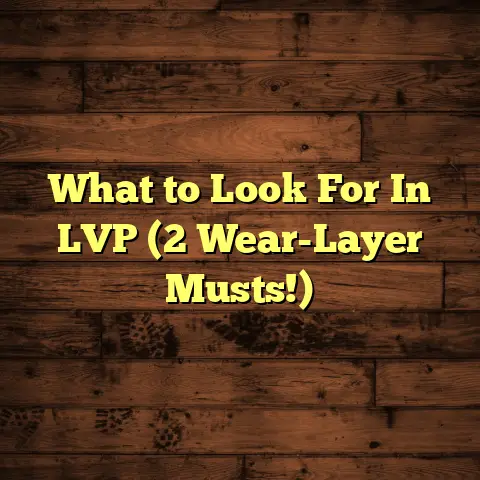Castile Soap Cleaning Tips (6 Surfaces Ruined!)
One of the most common culprits behind unexpected home damage is something that seems so innocent: Castile soap.
I know, I know, it’s the darling of the natural cleaning world.
But trust me, I’ve seen firsthand how this supposedly gentle giant can wreak havoc on your precious surfaces.
Ever excitedly cleaned your hardwood floors with Castile soap, only to find them looking dull and streaky?
Or perhaps you’ve tackled your marble countertops, only to discover unsightly etching?
You’re not alone!
Today, I’m diving deep into the world of Castile soap and uncovering the truth about its potential pitfalls.
I’ll share my experiences, industry insights, and practical tips to help you avoid costly mistakes.
So, grab a cup of coffee, and let’s get started!
1. What IS Castile Soap Anyway?
Okay, before we get into the nitty-gritty, let’s define what we’re talking about.
Castile soap is traditionally made from olive oil, giving it a mild and gentle cleaning action.
It originated in the Castile region of Spain, hence the name.
Nowadays, you’ll find Castile soap made with other vegetable oils like coconut, palm, or hemp.
Its popularity stems from being biodegradable, non-toxic, and free of harsh chemicals.
Plus, it’s super versatile – people use it for everything from washing their hair to cleaning their homes.
But here’s the kicker: just because it’s natural doesn’t mean it’s safe for everything.
2. The Lure of the Natural Side
Let’s face it, we’re all trying to be a little more eco-conscious these days.
The trend towards natural cleaning products is booming, and for good reason.
We want to avoid harsh chemicals that can harm our families and the environment.
Castile soap fits perfectly into this narrative.
It’s marketed as a safe, effective, and sustainable cleaning solution.
According to a report by Grand View Research, the global green cleaning market is expected to reach $11.6 billion by 2027.
This shift in consumer demand is driven by a desire for products that are biodegradable, non-toxic, and environmentally friendly.
But, as I’ve learned the hard way, good intentions don’t always guarantee good results.
3. Hardwood Floors: A Recipe for Disaster?
Ah, hardwood floors. They’re beautiful, timeless, and a real investment.
So, imagine my horror when I started seeing clients complaining about dull, streaky floors after using Castile soap.
The problem? Castile soap has a high pH level.
When mixed with hard water, it can leave a dull film on your floors.
This film attracts dirt and grime, making your floors look even worse over time.
I’ve even seen cases where repeated use of Castile soap has caused the finish on hardwood floors to break down, leading to warping and discoloration.
Here’s a personal story:
I once had a client who swore by Castile soap for everything.
She used it on her beautiful oak floors, and at first, they looked great.
But after a few months, she noticed a hazy film that she couldn’t get rid of.
I had to break the news to her that the soap had damaged the finish, and the only solution was to refinish the entire floor.
Talk about a costly mistake!
The Science Behind the Damage:
The oils in Castile soap can react with the polyurethane finish on hardwood floors, creating a sticky residue.
This residue not only dulls the finish but also makes the floor more susceptible to scratches and scuffs.
The Fix:
- Avoid using Castile soap on hardwood floors.
- Use a pH-neutral cleaner specifically designed for hardwood.
- Always follow the manufacturer’s instructions.
- Consider a professional cleaning service for deep cleaning.
4. Marble Countertops: Etching and Discoloration Nightmare
Marble countertops are the epitome of luxury and elegance.
But they’re also notoriously delicate.
Castile soap is a big no-no for marble.
Why? Because marble is a porous stone, and Castile soap is alkaline.
When the two come into contact, a chemical reaction occurs that can lead to etching and discoloration.
Etching is the dulling or pitting of the marble surface, and it’s permanent.
Discoloration can occur when the soap seeps into the pores of the marble, leaving behind unsightly stains.
I’ve seen homeowners spend thousands of dollars on marble restoration after using Castile soap.
Homeowner Testimony:
“I used Castile soap on my marble countertops because I thought it was a safe, natural cleaner.
Big mistake! Now my countertops are covered in dull spots and water rings.
I’m so upset!” – Sarah M., Homeowner
The Science Behind the Damage:
Marble is made of calcium carbonate, which reacts with alkaline substances like Castile soap.
This reaction dissolves the surface of the marble, causing etching and damage.
The Fix:
- Never use Castile soap on marble countertops.
- Use a pH-neutral cleaner specifically designed for marble.
- Wipe up spills immediately to prevent staining.
- Consider sealing your marble countertops to protect them from damage.
5. Upholstery and Fabrics: Residue Buildup and Fading
Think your sofa is safe? Think again!
While Castile soap might seem gentle enough for fabrics, it can actually cause residue buildup and fading.
The soap can leave behind a film that attracts dirt and grime, making your upholstery look dingy over time.
I’ve also seen cases where Castile soap has caused watermarks and color fading, especially on delicate fabrics like silk or linen.
Professional Advice:
“As a cleaning professional, I advise against using Castile soap on upholstery.
It’s too alkaline and can leave behind a sticky residue that’s difficult to remove.
Stick to cleaners specifically designed for fabrics.” – Maria Rodriguez, Cleaning Professional
The Science Behind the Damage:
The oils in Castile soap can cling to fabric fibers, creating a residue that’s difficult to rinse out.
This residue can trap dirt and attract more soil, leading to a dull, dingy appearance.
The Fix:
- Test Castile soap on an inconspicuous area of the fabric before cleaning the entire piece.
- Use a diluted solution of Castile soap and rinse thoroughly.
- Consider using a fabric-specific cleaner for best results.
- Avoid using Castile soap on delicate fabrics like silk or linen.
6. Painted Surfaces: Stripping and Marking
Painted walls and furniture can add a pop of color and personality to your home.
But Castile soap can be a paint’s worst enemy.
I’ve seen DIYers encounter issues while cleaning painted furniture or walls with Castile soap, resulting in stripped paint or unsightly marks.
The soap can be too harsh for some paints, causing them to fade, peel, or even dissolve.
DIY Disaster Story:
“I decided to clean my kitchen walls with Castile soap because I wanted a natural cleaning solution.
I ended up stripping the paint off in several spots! Now I have to repaint the entire kitchen.” – John S., DIY Enthusiast
The Science Behind the Damage:
The alkalinity of Castile soap can break down the binders in paint, causing it to lose its adhesion and peel off the surface.
The Fix:
- Test Castile soap on an inconspicuous area of the painted surface before cleaning the entire area.
- Use a diluted solution of Castile soap and rinse thoroughly.
- Consider using a paint-safe cleaner for best results.
- Avoid using Castile soap on delicate or antique painted surfaces.
7. Stainless Steel Appliances: Streaks and Smudges Galore
Stainless steel appliances are sleek and modern, but they can be a pain to keep clean.
Castile soap can exacerbate the problem by leaving behind streaks and smudges.
I’ve seen countless clients struggle to achieve a pristine finish after using Castile soap on their stainless steel appliances.
The soap can leave a film that’s difficult to remove, resulting in a less-than-pristine finish.
The Science Behind the Damage:
The oils in Castile soap can cling to the surface of stainless steel, creating a film that attracts fingerprints and smudges.
The Fix:
- Avoid using Castile soap on stainless steel appliances.
- Use a stainless steel cleaner specifically designed for appliances.
- Wipe in the direction of the grain to avoid streaks.
- Use a microfiber cloth for best results.
8. Glass and Mirrors: A Streaky Situation
Want to see clearly? Don’t use Castile soap!
While it might seem like a gentle option for cleaning glass and mirrors, Castile soap can leave behind streaks and a hazy film.
I’ve heard countless stories of individuals struggling to achieve a clean, clear surface after using Castile soap.
The soap can leave a residue that’s difficult to remove, resulting in a less-than-sparkling finish.
The Science Behind the Damage:
The oils in Castile soap can cling to the surface of glass and mirrors, creating a film that refracts light and causes streaks.
The Fix:
- Avoid using Castile soap on glass and mirrors.
- Use a glass cleaner specifically designed for windows and mirrors.
- Use a microfiber cloth for best results.
- Consider using a vinegar and water solution for a natural alternative.
9. The Double-Edged Sword of Castile Soap
So, there you have it.
Castile soap, while seemingly harmless, can be a real troublemaker in certain situations.
The common thread among users across various surfaces is disappointment.
We all want a safe, natural cleaning solution that works.
But it’s crucial to understand how different products interact with different materials.
The Takeaway:
Before you reach for that bottle of Castile soap, take a moment to consider the surface you’re cleaning.
Do your research, read reviews, and test the product in an inconspicuous area first.
A little caution can save you a lot of headaches (and money!) in the long run.
Remember, I’m here to help you navigate the world of home improvement and avoid costly mistakes.
Don’t hesitate to reach out with any questions or concerns.
Happy cleaning (safely!) everyone!





